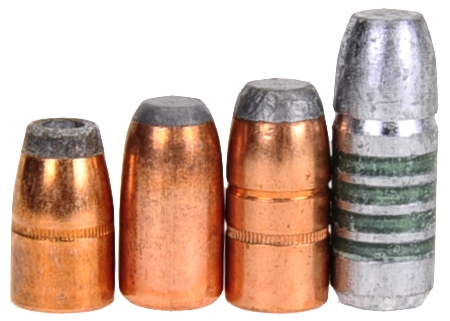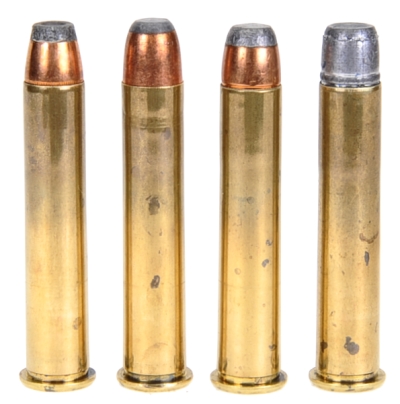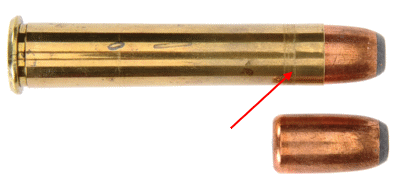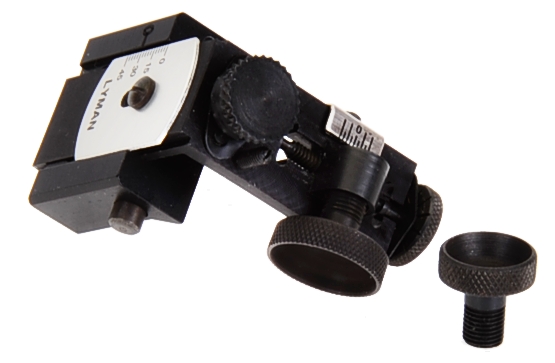
Mowing the lawn puts one into a contemplative frame of mind. I don’t know why. Perhaps its the drone of the tractor engine or the sense of order that comes from arranging a slightly neglected lawn into neat rows and squares of thick contrasting texture? It may also be the monotony of cutting the same lawn over, and over, and… Possibly, prolonged exposure to an overly rich carburetor, gas fumes and summer heat. In any event, mowing caused me to reflect on the Winchester Model 1886 project.
The combination of Winchester Model 1886 and Winchester 45-90 WCF cartridge was new to me; lots of experience with the rifle in concert with every other historical chamber, but not with the 45-90 WCF. Subsequently, a project scheduled for forty man hours went on beyond eighty hours. Every step forward led to some new information and I couldn’t bring myself to quit in the midst of getting an education… even if it meant finding that most of my initial assumptions were not lasting.
In it’s military origins, the 1873 45-70 was introduced in two version, the M1873 rifle cartridge 45-70-405 and M1873 carbine cartridge 45-55-405. The M1882 rifle was added as a 45-70-500, while the M1886 carbine cartridge remained as 45-55-405, but its powder type changed. As a civilian sportsman’s cartridge, ammunition grew into many forms. Lighter weight bullets were added to boost velocity and effective hunting ranges where, today, factory ammunition bullet weights range from 225 grains to 500+ grains. Restricting ammunition use to modern, stronger firearms moved pressure levels up from 28,000 PSI to +/- 40,000 PSI. One hundred forty five years, give or take, in use and even new generations find it an kick ass hunters cartridge.
In contrast.the 45-90 Winchester was developed as civilian cartridge, an attempt at high velocity before inevitability of high velocity small bore cartridges set in, where a .45 caliber 300 grain bullet from a vintage black powder cartridge could attain just under 2,000 fps. There are a good number of 45-90 Winchester handloads in heavyweight bullets up to 500 grains, but for the most part they are based on long, round nose cast bullets. There overall length that make them mostly suitable for single shot rifles like the Model 1885 Winchester. The Winchester Model 1886 lever action limits the 45-90 Winchester to to an overall length of 2.880″ in best case scenarios, with 2.850″ more typical maximum length,
Where the 45-70 Gov’t has been endlessly flogged at original and more modern performance levels and readily available, the .45-90 WCF has been more or less focused on Cowboy Action Shooting and Black Powder Cartridge Rifle Silhouette shooting. Tough finding factory loaded ammo, a supply of brass makes it a handloader’s cartridge. It seems to me that the the 45-90 Winchester offers approximately 10 grains of H20greater capacity than the .45-70 and, in common firearms, somewhat greater potential as often suggested to be a 200 fps pickup.
Why did the 45-70 flourish and remain while the 45-90 languished? Rifles chambered for the 45-70 were common in brands and types, while the exceptional length of the 45-90 put it in the Winchesters Model 1885 and Model 1886 and Marlin’s Model 1895. There was no supply of inexpensive 45-90 military firearms as there was for the 45-70. There was no wide variety of 45-90 loads to suit a wide array of applications as was the case of the 45-70. Still, by the mid 1930s, firearms for both cartridges were deemed obsolete and dropped from manufacturers’ catalogues. Forty years later, 45-70 lever guns made a come back, supported by handloading opportunity and a whole range of new, high performance ammunition. The 45-90 WCF has also made a comeback, but to more discrete use, handload activity, but without the support of ammunition manufacturers.
There is a CIP standard cartridge that is the equivalent of a modern 45-90 Winchester for use in modern rifles, the 45-70 WM (Winchester Magnum), is a German petition from 2003 and revised in 2004. The case length is 2.400″, but the overall cartridge length is 82.0mm or 3.228″, well beyond lever action capacity. Of additional interest, the Ptmax – maximum average pressure is 2200 BAR or 31,901 PSI as a SAAMI MAP equivalent. Reamer for this cartridge that are available from Pacific Tool and Gauge are the same as the 45-90 Winchester with the exception of a longer throat to accommodate the 45-90 WM’s greater length.
Useful hunting bullets…
My original list began here…

but eventually ended here…
Below far right, a 460 grain bullet replaced the original 500 grain True Shot selection pictured above right. for a number of reasons. While I could get the 500 grain bullet to work dimensionally with some cartridge case modification and the Winchester Model 1886, the bullet is a too soft alloy, it lacks a gas check and True Shot discontinued the bullet. Other than those minor drawbacks, it was an amazing selection… yes, sarcasm. It was replaced with the Cast Performance 460 grain bullet, hard cast, with a gas check and a dimensional fit.

L-R above – The Sierra Pro-Hunter 300 grain hollow point, flat nose bullets is one I have used routinely with 45-70 performance ammunition. It is unique in that Sierra recommends it for muzzle velocity as low as 1300 fps in handguns like the Thompson / Center single shot pistols and as high as 2,500 fps in concert with the 458 Winchester Magnum. The bullet holds together and expands reliably, although its ballistic coefficient might be described as flying barn door…ish.
The copper jacketed Hawk Precision 350 grain bullet was also selected because of successful experience with the modern, higher than standard velocity 45-70 Gov’t handloads. This one has an 0.025″ thick jacket, but the company also offers this with an 0.035″ jacket and cannelure placed as desired. Speer also makes an excellent 350 grain soft point flat nose bullet but, while it works for the 45-70, its ogive is too long for 45-90 Winchester lever gun use.
The Speer soft point flat nose 400 grain bullet works well with lever action rifles and 45-70 Gov’t performance handloads. A tough bullet, it expands at the anticipated velocity and it penetrates significantly in large game.
The far right is a 460 grain Cast Performance hard cast bullet that does not significantly expand, but it does penetrate really well. The 460 grain is the same bullet used in Grizzly high performance 45-70 ammunition at 1,800 fps and it has worked well for me with 45-70 handloads.
Early Winchester’s chambered for the 45-90 WCF had a twist rate of 1:32″ and the factory load was 45-90-300, a short, light for bore 300 grain bullet. The current Winchester Model 1886 has a 1:20″ twist which easily stabilizes the heaver bullet weights selected.
| Bullet | Type | Weight Grains |
Ballistic Coefficient |
Bullet Length Inches |
Seating Depth Inches |
Actual COL Inches |
| Sierra Pro-Hunter |
HPFN | 300 | 0.118 | 0.790 | 0.375 | 2.815 |
| Hawk Precision | SPFN | 350 | 0.214 | 0.890 | 0.460 | 2.830 |
| Speer | SPFN | 400 | 0.272 | 0.972 | 0.542 | 2.830 |
| Cast Performance | FNGC | 460 | 0310 | 0.120 | 0.675 | 2.825 |
| Cases trimmed to 2.380″ to affect overall length | ||||||
Notes….
Early modern reloading manuals, late 1950’s to early 1960’s, in my position list maximum cartridge overall length for the 45-90 Winchester as 2.718″ for bullets through 405 grains and in anticipation of lever action use. The current Lyman’s Cast Bullet Handbook lists COL as: 385 grain RN at 2.850″, 400 grain FN at 2.800″, 500 grain RN at 3.210″, and 535 grain RN at 3.300″. All but the flat nose are listed in anticipation of single shot use where magazine restrictions and feed mechanisms do not come into play.
Generally, the mechanical limit to cartridge overall length for the Winchester Model 1886 in 45-90 Winchester is 2.850″. Still, cartridges assembled with the Cast Performance broad flat nose bullet needed to be be no longer than 2.825″. Anything greater than this length and an assembled cartridge would not clear the insertion angle when pushed through the loading gate and into the tubular magazine. To facilitate use of the Cast Performance bullet, cases were trimmed to 2.380″, giving up 0.020″ of the 0.300″ gained over the 45-70 Gov’t and of no consequence.
All other bullets had enough ogive taper to clear at a maximum of 2.850″ reliably and use the standard maximum case length of 2.400″, but it seemed prudent to trim all cases to a uniform 2.380″ to reduce the chance of a mix up with brass. The trimming operation also provided the opportunity to clean up what I could only label as poor quality Bertram brass. The blotchy alloy appeared to be made from old salvaged doorknobs and the case mouths looked as though they were cut to length with a dull hacksaw. Why did I use Bertram? Because it was available when quality Starline brass was not and I didn’t mind prepping the cases for this occasion.
A relatively narrow selection of powder types were selected based on mainstream reloading data and prior experience with moderate pressure, high capacity cartridges. IMR 4198 was first produced in the 1930’s when IMR was a Du Pont product, originally developed for the 30-30 WCF. IMR 4198 produces uniform pressure in case full and moderate fill loads. H4198, in my experience, is not a direct substitute and requires its own load data.
Reloder 7 shares many of the characteristics of IMR 4198 and it is similar in burn rate. In production since 1965, once under the Hercules Powder brand, it went out of production in 1971 was later revived by Alliant Powder. It works well in smokeless versions of old large capacity black powder cartridges and produces uniform pressure in case full and moderate fill loads.
Reloder 10x was added in deference to the larger than 45-70 Gov’t case. It is a bit slower than Reloder 7 and, based on Alliant’s load data, 10x also has applications in small bore bore and large capacity, old black powder cartridges. I tend to use 10x in many of my 45-70 handloads.
Trail Boss has a place wherever there are large capacity, big bore cartridges and a need for reduced loads. The powder is so bulky light charges will fill most any cartridge case.
Handloads*
Warning: Bullet selections are specific, and loads are not valid with substitutions of different bullets of the same weight. Variations in bullet length will alter net case capacity, pressure and velocity. Primer selection is specific and primer types are not interchangeable. These are maximum loads in my firearms and may be excessive in others. All loads should be reduced by 5% as a starting point for development where cartridges have greater than 40 grains in capacity and 10% for cartridges with less than 40 grain capacity following safe handloading practices as represented in established mainstream reloading manuals. Presentation of these loads does not constitute a solicitation for their use, nor a recommendation.
| Cartridge |
45-90 Winchester |
| Firearm | Winchester Model 1886 |
| Barrel Length | 24″ |
| Max Case Length | 2.400″ +0.0″/-0.020″ |
| Max COL M1886 |
2.850″ |
| Primer | Remington 9 1/2 – Large Rifle |
| Bullet Diameter | 0.458″ +0.0″/-0.003″ |
| Reloading Dies | Lyman Precision |
| Bullet Type | Bullet Weight Grains |
Net H2O Grains Capacity |
COL” | Powder Type | Powder Charge Grains |
Muzzle Velocity fps |
Muzzle Energy ft/lbs |
| Sierra Pro-Hunter JHP | 300 | 73.3 | 2.835 | Re7 | 59.0 | 2307 | 3546 |
| Sierra Pro-Hunter JHP | 300 | 73.3 | 2.835 | Re10 | 62.0 | 2320 | 3586 |
| Sierra Pro-Hunter JHP | 300 | 73.3 | 2.835 | IMR4198 | 57.0 | 2376 | 3762 |
| Sierra Pro-Hunter JHP | 300 | 73.3 | 2.835 | Trail Boss | 22.0 | 1350 | 1214 |
| Hawk Precision SPFN | 350 | 69.7 | 2.850 | Re7 | 55.0 | 2173 | 3674 |
| Hawk Precision SPFN | 350 | 69.7 | 2.850 | Re10x | 58.0 | 2175 | 3677 |
| Hawk Precision SPFN | 350 | 69.7 | 2.850 | IMR4198 | 53.5 | 2157 | 3617 |
| Hawk Precision SPFN | 350 | 69.7 | 2.850 | Trail Boss | 22.0 | 1299 | 1312 |
| Speer SPFN | 400 | 66.3 | 2.850 | Re7 | 53.0 | 2017 | 3614 |
| Speer SPFN | 400 | 66.3 | 2.850 | Re10x | 55.0 | 2045 | 3715 |
| Speer SPFN | 400 | 66.3 | 2.850 | IMR4198 | 50.0 | 2008 | 3582 |
| Speer SPFN | 400 | 66.3 | 2.850 | Trail Boss | 21.0 | 1165 | 1206 |
| Cast Performance |
460 | 59.6 | 2.825 | Re7 | 46.0 | 1811 | 3351 |
| Cast Performance |
460 | 59.6 | 2.825 | Re10x | 49.5 | 1861 | 3538 |
| Cast Performance |
460 | 59.6 | 2.825 | IMR4198 | 45.0 | 1838 | 3451 |
| Cast Performance |
460 | 59.6 | 2.825 | Trail Boss | 18.0 | 1015 | 1053 |

The Lyman dies did a good job of sizing, expanding and bullet seating, including those with a cannelure that received a roll crimp. The seater plug was pretty rough and marred where it came in contact with bare lead. A little polishing would clean up the and contour the plug.

The Hawk Precision bullet did not have a cannelure, but I was able to use a 45-70 Lee Factory Crimp Dies to grab at the bullet shank as illustrated above. Not unlike the knurled crimp Remington uses on factory 45-70 ammo, I just didn’t want to use bullets that weren’t anchored in a tubular magazine in a rifle with recoil of consequence.
Rounds loaded easily, into the magazine and when fed into the chamber. Extraction and ejection was rock solid reliable and with more than enough ejection force to clear the rifle and shooter.
Winchester Model 1886 & 45-90 Winchester conclusions…
I enjoy handloading and developing loads, so I found the Winchester Model 1886 in 45-90 Winchester very appealing. I could see spending a year developing optimal handloads for recreational target shooting and hunting. The big cartridge seems to be able to produce 45-70 performance level loads without the cartridge and pressure stress.
I’ve seen routinely referenced in social media and some publications that 45-70 ammo can be used where 45-90 is not available. I don’t share that view as cast bullet residue can accumulate at the chamber’s end and create restrictions that elevate chamber pressure or even prevent chambering a 45-90 round. Not great for accuracy, bullets must jump an 0.300″ gap between the cartridge case mouth and the chamber throat. I do not think there is enough taper difference to cause a split case mouth. Checking with Winchester tech, the company’s position is that the only proper ammunition is the cartridge stamped on the barrel and they specifically do not support this substitution.
Unlike my Marlin 1895 Guide Gun, the Winchester Model 1886 is not a stubby carbine, but rather a 24″ barrel rifle, which pays good dividends in the form of higher velocity and a long sight radius which benefits metallic sights. I did not post 100 yard group sizes, not because of the rifle’s performance limitations, but because of mine. I typically shoot groups off of a sled and with a relatively high power scope to minimize the influence of eyesight and marksmanship skills on the outcome, but the Model 1886 does not accommodate scope mounting

Shooting was done with a Lyman peep sight using both target and hunting aperture, mostly at 100 yards where it was quite easy to put three shots in an inch and one half to two inches. I can’t think of anything in the way of medium and large game that would not fall to that level of accuracy at any distance reasonable for the cartridge. In the case of the 45-90 Winchester that would easily be 300 yards with a 400 grain Hawk Precision bullet.
| Best Zero Results 6″ Critical Target | |||||||
| Near-Zero – yards | 18 | Mid Range – yards | 93 | ||||
| Far-Zero – yards | 162 | Max Ordinate – in. | +3.0 | ||||
| Point Blank – Yards | 172 | ||||||
| 45-90 Winchester 400 Grain Hawk Precision Bullet | ||||||||||||
| Yards | 0 | 50 | 100 | 150 | 200 | 250 | 300 | |||||
| Velocity – fps | 2045 | 1873 | 1710 | 1558 | 1421 | 1299 | 1196 | |||||
| Energy – ft.-lbs. | 3714 | 3115 | 2596 | 2157 | 1794 | 1499 | 1271 | |||||
| Momentum – lbs-sec | 117 | 107 | 98 | 89 | 81 | 74 | 68 | |||||
| Path – in. | -1.50 | 3.13 | 5.27 | 4.43 | 0.00 | -8.74 | -22.63 | |||||
| Drift – in. | 0.00 | 0.00 | 0.00 | 0.00 | 0.00 | 0.00 | 0.00 | |||||
| Time Of Flight – sec. | 0.00 | 0.08 | 0.16 | 0.25 | 0.35 | 0.46 | 0.58 | |||||
There are black powder silhouette shooting competitors that can knock over relatively small targets at 1,000 yards. But in hunting, targets don’t openly present themselves, they are rarely stationary and 1,000 ft-lbs of energy or proportional levels of momentum are required for adequate bullet penetration and expansion.
The Winchester Model 1886 and 45-90 Winchester is much more than the average plastic stocked $400 bolt action rifle deer hunter’s rifle. For a true enthusiast the combination is an adventure; marksmanship proficiency building, woodland hunting, handload development. There will always be a lot of the shooter’s knowledge and ability wrapped up in the outcome. An excellent example of John Browning’s firearm design talents, well executed by a quality firearm company.
*Sources for historical reference and/or foundation data:
“Lyman Cast Bullet Handbook 4th Edition”
“Lyman’s Reloader’s Handbook 42nd Edition”
“Propellant Profiles” – Wolf Publishing
“Ballistics of Cartridges” – Charles Newton
“Loading Cartridges For The Original .45-70 Springfield Rifle and Carbine”, J.S. and Pat Wolf.

Email Notification